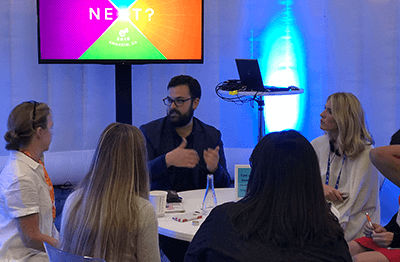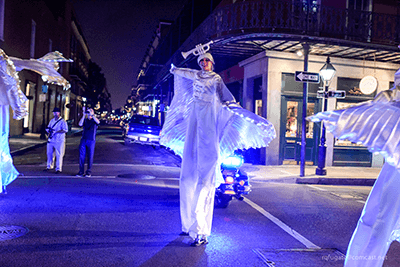
In today’s world, consumers overwhelmingly choose brands, communities and experiences based on shared values and purpose. People want greater connection and seek more substantive forms of gratification in everything—including their events. To meet your prospective guests’ needs, you need to make a bigger effort to know them intimately. And, organizations that are making a conscious effort to uncover the human needs that experiences can and should fulfill are outperforming those who are not.
Old Thinking Won't Bring New Results
Most event survey tools take a “rear-view mirror” approach to measuring attendee satisfaction. Just doing a post-event survey to gauge attendees’ opinions on the superficial features of your event won’t provide you with the information you need to truly understand your audience. Great experience design is rooted in empathy, according to Tim Simpson, design strategist at Maritz.
“Great experience design is
rooted in empathy”
– Tim Simpson
Design Study Provides the Answer
The goal of going deeper through a design study is to empathize with the values of the attendees. With that knowledge, organizations can build the foundation of experiences where brand values and purpose intersect with those of attendees. Simpson says this connection holds the key to unlocking deeper economic value for guest and brand alike. And conversely, failure to foster that connection can lead to brand erosion, a failure to draw new guests or the loss of repeat attendees.
How Do You Know it’s Time for a Design Study?
Tammy Smith, research director at Maritz, cites four scenarios that necessitate adding a Design Study step to your design process:
- Stagnancy – Organizations that need to make their events more impactful or have declining attendance need to ask tough questions like: does your model appeal to the next generation of attendees and are there legacy aspects of your event that attendees no longer value?
- Declining Budgets – Organizations being asked to deliver a better experience with fewer resources need to know what’s most impactful to attendees as they make decisions and trade-offs.
- Focus on ROI – Event professionals are constantly asked to demonstrate the return for their programs. A Design Study that is closely linked to business outcomes can measure the impact the event has on the organizations’ strategic priorities.
- When You Think You Know – New leaders of event programs have an opportunity to gain a fresh view that’s free of expectations.
Especially in cases like those listed above, organizations need insights that can’t be gleaned from standard post-event surveys. According to Smith, this calls for undertaking a deliberate Design Study with a wider scope and deeper focus. New insights often reveal different directions that can lead to transformative change, greater ROI and other benefits.
Pointers for Engineering and Executing the Design Study Process:
- Widen your lens. Investigate the needs, wants and concerns of non-attenders too. This group is usually overlooked by organizations, according to Smith, who explains, “If you want to appeal to people not attending, you need to understand them, too.”
- Probe for prevailing values. Ask what your audience really cares about—and how they care. One of the ways our teams do this in design studies is by getting interviewees to choose the value category they identify with from a grid of options. For example, two of the categories are “pioneers” who like change and being first and “altruists” who are outwardly-focused and service-oriented. By getting respondents to self-identify through this exercise, we can point clients to the value or groups of values event organizers should be designing to.
- Listen for the bad as well as the good. Keep an open mind when hearing the audience’s problems and frustrations about past events or reservations about attending future ones. And be sure to listen for the event’s strengths as well—those are the elements we counsel clients not to change.
- Use design studies to counter or confirm assumptions. The most important point is to ensure your audience’s views are represented during design. This makes design studies the antidote to the dangers of bias, group think, falling back on assumptions and catering to compromise. Smith explains, “The difference is making a room of people happy versus making your audience members happy.”
- Leverage the power of the outside perspective. Even with the “truth” of the Design Study team in hand, there can still be a tendency for the group to cling to assumptions and resist change. That’s why having an outside perspective is often a tremendous advantage. “It’s not easy to challenge your assumptions from the inside,” Smith says. “Having an unbiased partner using proven diagnostic methods can lead to deep insights that you wouldn’t be able to do on your own. And there’s a likelihood that you wouldn’t believe them or would find a way to prove them wrong.”
A Design Study Can Have Big Payoffs
Simpson cites the success of a recent Design Study performed for an association trying to grow its event. The results were breakthrough in every way. “You could see the board’s faces and demeanor change as they heard the results. The findings set the tone for the design lab that followed by validating some of the group’s beliefs and challenging others,” he said. “In the end, the Design Study helped them overcome internal disagreement. The facts about people led to a lot of decisions about how to alter big characteristics around networking, education and the event’s overall length.”
It just goes to show how in the face of differing opinions and long-held assumptions, the customer is always right. Know the customer and you’ll know the path to success. This is true for organizations of all size and event types, whether corporate, association, government or live event. The starting point should always be people.
That makes design study an essential precursor to experience design today. The good news is that design studies can vary to suit your bandwidth and your budget—from simply adding additional questions to your post-event questionnaire to launching a broad-reaching survey of your audience members’ values and perspectives. If you need help determining the scope and form for your gathering, our Design Studio team is here to assist. Book a 30-minute design consultation with one of our experts.


